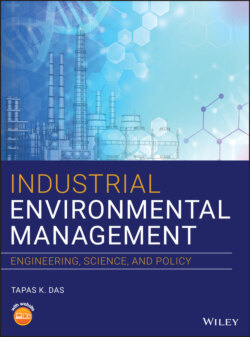Читать книгу Industrial Environmental Management - Tapas K. Das - Страница 25
1.7 Sustainability, Industrial Ecology, and Zero Discharge (Emissions)
ОглавлениеThe concept of Zero Discharge or Zero Emissions is the key to sustainable development but is by itself a subset of industrial ecology (also see Section 9.2) (see Figure 1.3).
Sustainability can be defined as follows: “Sustainable development” is the challenge of meeting human needs for natural resources, industrial products, energy, food, transportation, shelter, and effective waste management while conserving and protecting environmental quality and the natural resource base essential for future development; and “the development that meets the needs of the present without compromising the ability of future generations to meet their own needs” (World Commission on Environment and Development 1987). Sustainability is a worthy vision, but inherently ambiguous, and inescapably expressed in value‐laden terms subject to differing ideological interpretations. Accordingly, while the concept provides a useful direction, it is almost impossible to put into operation. Standing alone, it can guide neither technology development nor policy formulation.
Industrial ecology is “an approach to the design of industrial products and processes that evaluated these activities through the dual perspectives of product competitiveness and environmental interactions.” The field has been developed, largely academically, over the last 10 years to be “the means by which humanity can deliberately and rationally approach and maintain a desirable carrying capacity” (Graedel and Allenby 1995). It can be thought of as the science of sustainability for industrial systems – the multidisciplinary study of industrial and economic systems and their linkages with fundamental natural systems (also see Section 9.2).
Even though it is still under development, industrial ecology can provide the theoretical scientific basis upon which understanding, and reasoned improvement, of current practices can be based. It incorporates, among other things, research involving energy supply and use, new materials, new technologies, basic sciences, economics, law, management, and social sciences. It encompasses concurrent engineering, design for the environment (DFE), dematerialization, pollution prevention, waste conversion, waste exchange, waste minimization, and recycling, with Zero Emissions as an important subset. Industrial ecology can be a policy tool, but it is neither a policy nor a planning system.
The goal of Zero Emissions is to restructure manufacturing so that there are no wastes. “Zero emissions” is thus applied “industrial ecology” at the manufacturing/service level, and indeed the terms are often used interchangeably. Note that the emphasis is on the manufacturing level, and not firm or industry level: whereas both “firm” and “industry” imply singular facilities or sectors, wastes are converted most successfully when several facilities are linked in an industrial cluster. As can be seen in Figure 1.4, pollution prevention and waste minimization are part of Zero Emissions and are technologies to be explored and where possible, optimized. Since it is not always feasible to prevent the generation of wastes early in the industrial cycle, the practice has arisen of trading them after they have been generated. Thus, critical components of ZD are waste exchange and the conversion of wastes so that they are viable inputs in other sectors. This interaction of systems widens the focus of the waste management effort.
Figure 1.3 Zero discharge (emissions) is a subset of industrial ecology (see Section 9.2). Design for the environment and dematerialization are discussed later in the chapter. Industrial metabolism compromises the energy and value‐yielding process essential to economic development.
Figure 1.4 Zero discharge is supported by an array of tools and methodologies.
